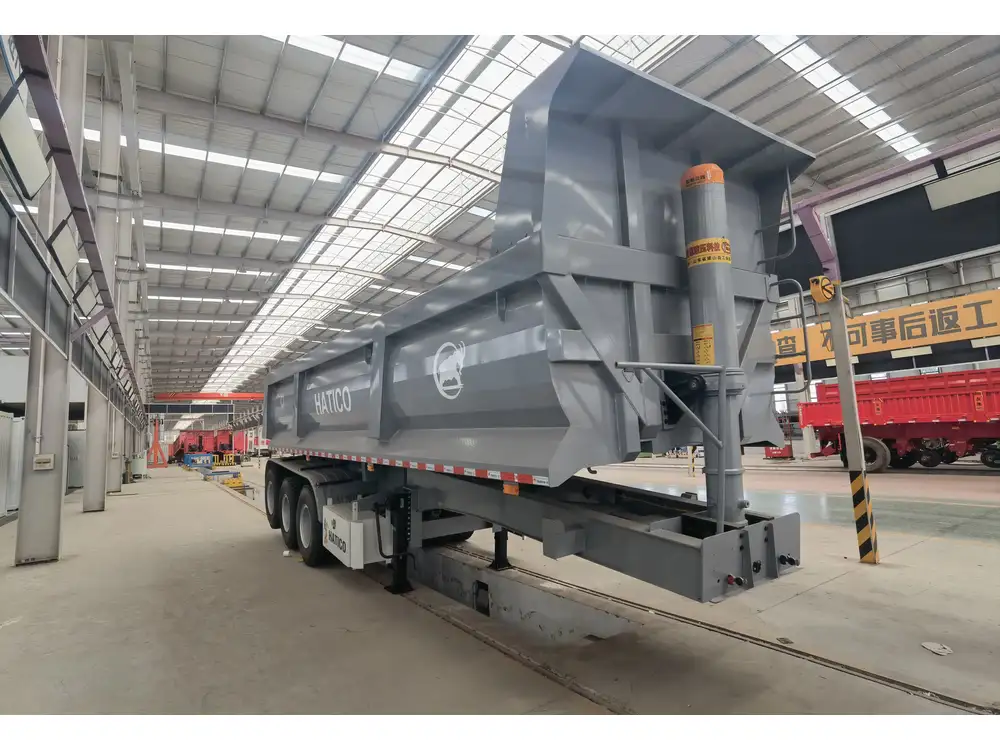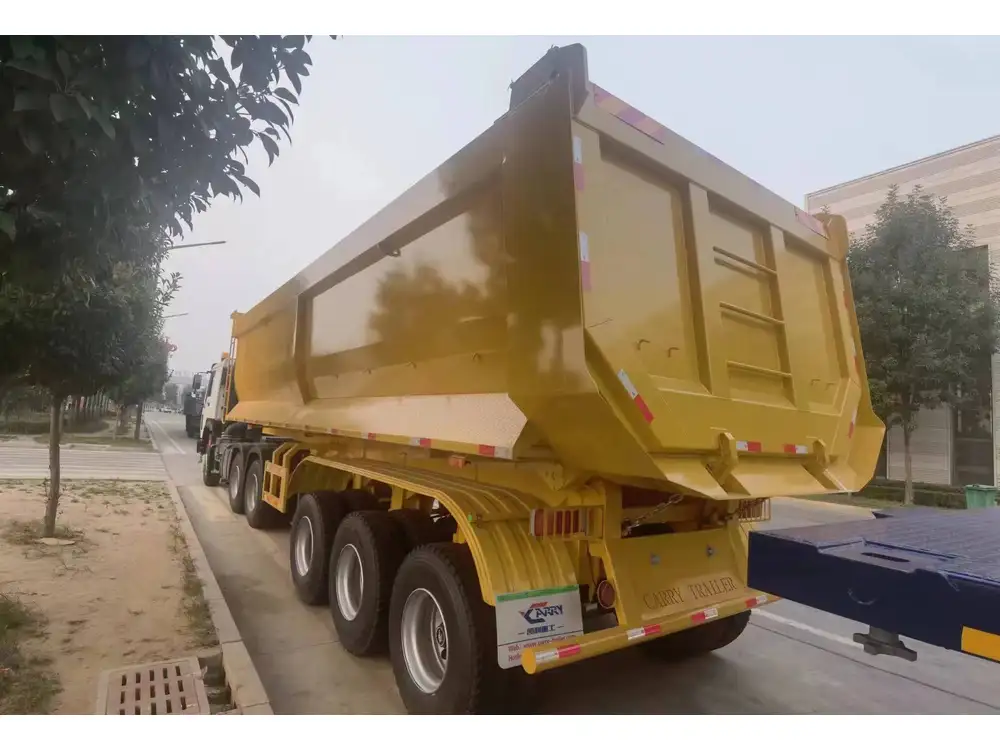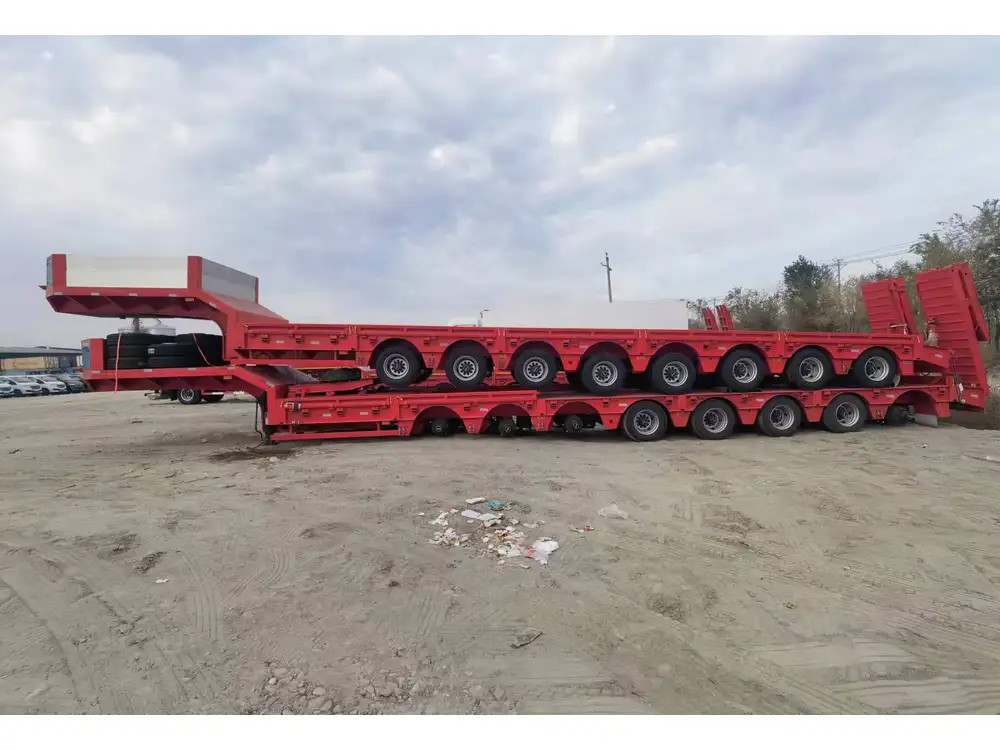In the dynamic realm of transportation and logistics, the securement of loads on flatbed trailers stands as a critical factor in ensuring safety, compliance, and operational efficiency. At CarMax Trailer, we understand that effective load securement is not merely a regulatory requirement but a foundational practice that safeguards cargo, drivers, and the general public. This comprehensive guide delves into the intricacies of flatbed load securement, offering detailed insights and best practices to help you achieve optimal results.
Understanding Flatbed Load Securement
Flatbed load securement involves the methods and devices used to stabilize cargo on flatbed trailers, preventing movement during transit. Unlike enclosed trailers, flatbeds expose cargo to environmental elements and require robust securing techniques to maintain stability. Proper securement mitigates the risk of accidents, cargo damage, and legal repercussions.
Key Components of Flatbed Load Securement
- Anchor Points: Strategic locations on the trailer where tie-downs attach.
- Tie-Downs: Straps, chains, or ropes used to secure cargo to anchor points.
- Load Distribution: Evenly spreading the weight of cargo to maintain trailer balance.
- Blocking and Bracing: Physical barriers that prevent lateral movement of cargo.

Regulatory Standards and Compliance
Compliance with federal regulations is paramount in load securement. The Federal Motor Carrier Safety Administration (FMCSA) outlines specific guidelines to ensure safety on the roads. Adhering to these standards not only fulfills legal obligations but also upholds industry best practices.
FMCSA Load Securement Regulations
- Cargo Weight: Not exceeding the trailer’s payload capacity.
- Tie-Downs: Adequate number and strength to prevent movement.
- Blocking and Bracing: Effective methods to secure loads.
- Inspection and Maintenance: Regular checks to ensure the integrity of securement devices.
International Standards
For companies operating globally, understanding and complying with international load securement standards is essential. Standards such as the European Norm (EN) and the International Organization for Standardization (ISO) provide frameworks for safe cargo transportation across borders.

Best Practices for Effective Load Securement
Implementing best practices in load securement enhances safety, efficiency, and compliance. Here are proven strategies to master flatbed load securement:
1. Assessing the Cargo
Prior to securing the load, conduct a thorough assessment to understand its dimensions, weight, and stability. This evaluation informs the selection of appropriate securement methods and equipment.
2. Selecting the Right Equipment
Choose securement devices based on cargo type and weight. Commonly used equipment includes:
- E-Track Systems: Versatile systems offering multiple anchor points.
- Ratchet Straps: Provide high tension and reliability.
- Chains and Binders: Ideal for heavy or oversized loads.
- Blocks and Dunnage: Used to stabilize cargo and prevent shifting.

3. Proper Load Distribution
Evenly distribute the weight of the cargo to maintain trailer balance. Uneven loads can lead to trailer sway, reduced braking efficiency, and increased wear on suspension systems.
4. Securing Points and Tension
Ensure that tie-downs are anchored to designated points on the trailer and that they are tensioned adequately. Over-tensioning can damage cargo, while under-tensioning may fail to prevent movement.
5. Utilizing Blocking and Bracing
Implement blocking and bracing techniques to restrict lateral movement. Blocks made from wood or other sturdy materials can be placed between cargo items, while bracing systems provide additional support.

6. Conducting Regular Inspections
Frequent inspections of securement devices and cargo stability are essential. Check for signs of wear, corrosion, or loosening of tie-downs, and make necessary adjustments promptly.
Advanced Techniques in Load Securement
For complex or high-value shipments, advanced securement techniques provide an additional layer of safety and protection.
Load Mapping and Planning
Developing a load map involves planning the placement and securement of each cargo item. This strategic approach ensures optimal weight distribution and minimizes the risk of shifting.

Dynamic Load Monitoring
Employing technology such as load sensors and GPS tracking systems allows real-time monitoring of cargo movement and trailer dynamics. This proactive approach enables immediate corrective actions if instability is detected.
Custom Securement Solutions
For unique or oversized loads, custom securement solutions tailored to the specific requirements of the cargo can enhance safety and efficiency. Collaborating with securement specialists ensures that specialized needs are met effectively.
The Role of Technology in Load Securement
Technological advancements have revolutionized load securement practices, offering innovative solutions to enhance safety and efficiency.

Automated Securement Systems
Automated systems streamline the securement process by providing precise tensioning and placement of tie-downs. These systems reduce human error and ensure consistent securement practices.
Load Tracking and Management Software
Sophisticated software platforms enable comprehensive load tracking and management. These tools provide detailed insights into load movements, securement status, and compliance metrics, facilitating informed decision-making.
Smart Sensors and IoT Integration
Integrating Internet of Things (IoT) devices and smart sensors into flatbed trailers offers real-time data on cargo conditions. This integration supports predictive maintenance and enhances the overall security of transported goods.

Common Challenges in Flatbed Load Securement
Despite best efforts, several challenges can arise in the process of load securement. Addressing these challenges proactively enhances overall safety and operational efficiency.
Variable Cargo Sizes and Shapes
Handling diverse cargo sizes and shapes requires adaptable securement strategies. Utilizing adjustable anchor points and versatile tie-downs can accommodate varying cargo configurations effectively.
Environmental Factors
Exposure to extreme weather conditions, such as high winds, rain, or snow, can impact load stability. Employing weather-resistant securement devices and regularly monitoring cargo during transit mitigates these risks.

Human Error
Mistakes in securement practices can compromise cargo safety. Comprehensive training programs and standardized securement procedures reduce the likelihood of human error.
Training and Education for Effective Securement
Investing in training and education ensures that personnel are equipped with the knowledge and skills necessary for proper load securement.
Comprehensive Training Programs
Developing training programs that cover the fundamentals of load securement, regulatory requirements, and practical securement techniques enhances employee competence and confidence.

Certification and Continuous Learning
Encouraging certification in load securement standards and promoting continuous learning keeps teams updated on the latest best practices and technological advancements.
Practical Workshops and Simulations
Hands-on workshops and simulation exercises provide valuable practical experience, reinforcing theoretical knowledge and enhancing problem-solving abilities in real-world scenarios.
CarMax Trailer: Your Partner in Load Securement Excellence
At CarMax Trailer, we are committed to delivering high-quality flatbed trailers designed to facilitate effective load securement. Our trailers incorporate advanced features such as multiple anchor points, durable construction, and compatibility with a wide range of securement devices. By partnering with CarMax Trailer, you gain access to equipment that supports your commitment to safety, compliance, and operational excellence.

Customizable Trailer Solutions
We recognize that each transportation requirement is unique. Our customizable trailer solutions allow you to tailor your flatbed trailers to meet specific securement needs, ensuring optimal performance and reliability.
Quality and Durability
CarMax Trailer’s products are built to withstand the demands of rigorous transportation environments. Our focus on quality and durability ensures that your investment delivers long-term value and dependable service.
Expert Support and Consultation
Our team of load securement experts is available to provide guidance and support, helping you implement best practices and select the right equipment for your operations.

The Future of Flatbed Load Securement
As the transportation industry evolves, so do the standards and technologies associated with load securement. Staying ahead of these developments ensures ongoing safety and efficiency.
Sustainable Securement Practices
Embracing sustainable practices, such as using eco-friendly materials for tie-downs and reducing waste in securement processes, aligns with environmental stewardship goals and regulatory trends.
Autonomous and Semi-Autonomous Systems
The integration of autonomous and semi-autonomous systems into flatbed trailers offers enhanced securement capabilities, providing precise control and monitoring of cargo during transit.

Enhanced Data Analytics
Leveraging data analytics allows for the optimization of load securement strategies based on historical data and predictive modeling. This approach enhances decision-making and operational planning.
Conclusion
Mastering flatbed load securement is essential for ensuring the safety, compliance, and efficiency of your transportation operations. At CarMax Trailer, we are dedicated to providing the tools, expertise, and support necessary to excel in load securement practices. By implementing comprehensive securement strategies, adhering to regulatory standards, and embracing technological advancements, you can achieve superior results and maintain a competitive edge in the logistics industry.
Frequently Asked Questions

1. What are the most common types of tie-downs used in flatbed load securement?
The most common types of tie-downs include ratchet straps, cam buckle straps, chains, and ropes. Ratchet straps offer high tension and reliability, making them suitable for securing heavy loads. Cam buckle straps are easier to use and are ideal for lighter or medium-weight cargo. Chains provide exceptional strength for oversized or particularly heavy items, while ropes are versatile and can be used in various securement scenarios.
2. How often should load securement devices be inspected?
Load securement devices should be inspected before each use to ensure they are free from damage, wear, or defects. Additionally, regular maintenance checks should be conducted to assess the integrity of the trailer’s anchor points and securement systems. Frequent inspections help identify and address potential issues before they compromise load safety.
3. Can weather conditions affect load securement on flatbed trailers?
Yes, weather conditions such as high winds, rain, snow, and ice can significantly impact load securement. High winds can cause cargo to shift, while precipitation can make surfaces slippery, affecting the stability of securement devices. It is essential to use weather-resistant tie-downs and regularly monitor cargo during transit to address any shifting caused by adverse weather conditions.

4. What are the penalties for non-compliance with FMCSA load securement regulations?
Non-compliance with FMCSA load securement regulations can result in substantial penalties, including hefty fines and out-of-service orders for drivers and carriers. Additionally, non-compliance increases the risk of accidents, which can lead to further legal liabilities and damage to a company’s reputation. Ensuring adherence to all load securement regulations is crucial to avoid these consequences.
5. How can technology improve load securement practices?
Technology can enhance load securement practices through the use of automated securement systems, load tracking and management software, and smart sensors. Automated systems provide precise tensioning and placement of tie-downs, reducing human error. Load tracking software offers real-time insights into cargo movement and securement status, while smart sensors monitor conditions such as tension, load shifts, and trailer dynamics, allowing for proactive adjustments to maintain cargo stability.



